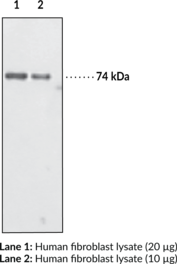Description
Polyethylene glycols (PEGs) are synthetic and hydrophilic polymers.{57302,57303} They are linear or branched and contain a reactive end group, such as acrylate, methacrylate, dibenzocyclooctynol, or vinyl sulfonate, for covalent attachment to macromolecules or linkers. The opposite end group of PEGs is commonly a methyl group (methoxy PEG), however, hydroxy, amino, butoxy, and tert-butoxy end groups have also been used.{57302} PEGs are non-toxic and are commonly used to prolong the in vivo circulation time of pharmaceutical agents.{57303} Free PEGs are non-immunogenic but become immunogenic when conjugated to a drug delivery nanosystem (DDS) or a macromolecule.{57302} Immunogenicity of PEGs varies based on polymer length and branching, end group composition, and chemical nature of the PEG acceptor structure. Cayman’s Polyethylene Glycol Rabbit Monoclonal Antibody can be used for ELISA, immunohistochemistry (IHC), and Western blot (WB) applications. The antibody recognizes PEGs containing a methoxy end group.
Synonyms: PEG
Immunogen: KLH-PEG with terminal methoxy group
Formulation: 100 µg of protein A-affinity purified antibody
Isotype: IgG
Applications: ELISA, IHC, WB
Origin:
Stability: 365 days
Application|ELISA||Application|Immunohistochemistry||Application|Western Blot||Product Type|Antibodies|Monoclonal Antibodies




